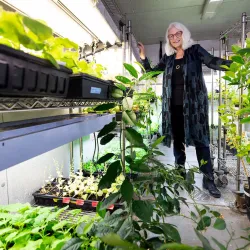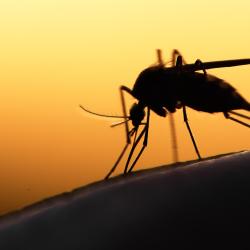Uncovering Clues to Chart Future Environmental Trends
Does history hold the key to predicting future climate changes? Paleoclimatologists—like Professor Alan Jay Kaufman and Associate Professor Michael Evans, who hold joint appointments in the Department of Geology and ESSIC—look for climate clues from the past by chemically examining samples of rocks, tree rings, corals and more. Using the college’s world-class geo-chemical laboratory facilities, they identify the isotopic composition of elements within their samples, yielding information about past environmental conditions.
“Paleoclimatology informs us about Earth’s natural pulses, providing us with a baseline for understanding today’s changes,” says Kaufman, who examines the rise in the planet’s oxygen level 2.5 billion years ago. Kaufman also studies ancient ice ages. His research explores the connection between ancient climate fluctuations and changes to biological communities. While conducting field work in arctic-Siberia in 2009, he found evidence for an unknown ice age some 543 million years ago, which he believes played a fundamental role in the evolution of modern animals.
Evans explores the more recent past—200 to 500 years ago—to uncover new findings about El Niño-Southern Oscillation (ENSO) cycles in the tropics, where ENSO causes extreme weather such as floods and droughts. “The question is whether ENSO’s behavior is going to change in the 21st century,” says Evans. His research team gathers hundreds of tree core samples from Queensland, Australia. Back on campus in a new Paleoclimate Laboratory in the Chemistry Building, the researchers measure the samples’ oxygen isotopic composition to track rainy and dry seasons and ENSO’s occurrence. Professor James Farquhar, Department of Geology and ESSIC, has used isotopic analysis to study environmental change occurring early in the Earth’s history. This research examines correlations between the carbon and sulfur isotopic compositions of 2.6 billion-year-old rocks from South Africa. His team, led by former Maryland Geology Research Scientist Aubrey Zerkle, now at England’s Newcastle University, linked oscillations of ocean methane levels with feedbacks involving an atmospheric haze. “We found a tipping point at which one climate regime flipped over to another and then flipped back,” Farquhar describes. The team hypothesizes that these two regimes were linked by chemistry and biology and controlled the amount of sunlight passing through the atmosphere, causing oscillations between cooler and warmer temperatures.
Charles Delwiche, a professor of Cell Biology and Molecular Genetics, studies the early evolution of oxygen-releasing photosynthetic organisms, which date back 2 billion years. One part of his research explores dinoflagellates—algae that are 200 million years old and have several types of chloroplasts. He applies DNA-based approaches, including genomic techniques, to address questions such as how photosynthetic chloroplast organelles became embedded in plant cells. His research also examines how photosynthetic dinoflagellates remove carbon dioxide from the atmosphere. Delwiche notes: “Understanding the evolution of our environment is extremely important in our ability to understand how the global environment might change in the future.”







